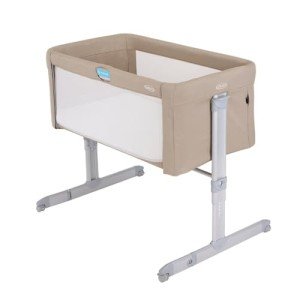Ten Bedside Crib For Attachment Parentings That Really Change Your Life

The Benefits of Bedside Cribs for Attachment Parenting
Attachment parenting is a child-rearing philosophy that stresses the significance of forming a strong emotional bond between a moms and dad and child. Among the essential components of this approach is co-sleeping, which promotes close physical distance between parents and their infants. Bedside cribs have gained substantial appeal as a useful and safe sleeping option that allows parents to practice attachment parenting successfully. Side Sleeping Crib explores the benefits of bedside cribs, their features, and crucial factors to consider for parents.
What is a Bedside Crib?
A bedside crib, likewise known as a sidecar crib, is a kind of infant sleeping plan that attaches safely to the side of a parent's bed. This design permits the baby to sleep in their own separate space while preserving easy access for feeding, reassuring, and tracking. Bedside cribs are available in different designs, from simple mesh designs to wooden cribs that match the decoration of the parents' bedroom.
Key Features of Bedside Cribs
When considering a bedside crib, it's vital to analyze its features to guarantee it fits the requirements of both moms and dad and baby. Here are some essential characteristics to watch out for:
| Feature | Description |
|---|---|
| Adjustable Height | Lots of bedside cribs have adjustable height settings to line up with the parent's mattress. |
| Side Panel Access | A side panel that can be reduced enables easy access to the baby throughout the night. |
| Tough Construction | Top quality products, such as strong wood or durable metal frames, supply stability and safety. |
| Security Features | Search for cribs with safety certifications and features such as safe and secure locking systems. |
| Breathable Materials | Bedside cribs typically utilize breathable fabrics to promote air flow, minimizing the risk of suffocation. |
Benefits of Bedside Cribs for Attachment Parenting
1. Promotes Bonding
Bedside cribs help with a nurturing environment where infants can notice their parents' existence, which fosters psychological security and attachment. The close proximity helps parents react more quickly to their baby's needs throughout sleep, promoting a sense of security and trust.
2. Ease of Feeding
For breastfeeding mothers, bedside cribs provide unequaled benefit for nighttime feeding. Mothers can easily reach their baby without getting out of bed, making late-night feedings less disruptive for both parent and kid.
3. Lowers Risks Associated with Co-Sleeping
While co-sleeping can promote attachment, it likewise carries risks such as suffocation and falling. Bedside cribs provide a compromise, offering a safe sleeping space for the baby while still permitting parents to sleep nearby.
4. Better Sleep for Parents
Given that parents can attend to their baby's needs without totally waking or leaving the bed, they can keep much better sleep quality. This is particularly essential during the early months when sleep deprivation can take a toll on adult health.
5. Increased Convenience
With a bedside crib, parents can quickly monitor their baby's movements and listen for any nighttime fussing, allowing for quicker interventions when required. This convenience is especially advantageous for parents requiring to handle their time successfully.
Choosing the Right Bedside Crib
When picking a bedside crib that aligns with the principles of attachment parenting, parents ought to think about numerous factors:
- Safety Standards: Always pick a crib that fulfills safety policies and guidelines to guarantee the infant's wellness.
- Size Compatibility: Ensure the crib fits firmly beside the moms and dad's bed and can be changed for height.
- Reduce of Access: Look for features that allow easy side access, especially useful for breastfeeding.
- Portability: If travel becomes part of household life, consider a crib that is lightweight and quickly transportable.
- Budget plan: Bedside cribs can be found in a range of price varieties. There are lots of cost effective options that do not jeopardize on safety or quality.
Frequently Asked Questions (FAQs)
Q1: Are bedside cribs safe for newborns?A1: Yes, bedside cribs are designed with safety functions to make sure a safe and secure sleeping environment for newborns. Constantly follow the maker's guidelines and safety requirements. Q2: Will my baby outgrow a bedside
crib quickly?A2: It depends upon the design. A lot of bedside cribs can accommodate
infants as much as 6-12 months, however it's essential to check the weight and height limitations specified by the producer. Q3: Can I use a bedside crib if I have a smaller bed?A3: Yes, numerous bedside cribs are adjustable and
can be lined up with different bed sizes. Always make sure the attachment is safe and secure. Q4: How does a bedside crib differ from co-sleeping? A4: Co-sleeping includes sharing the very same sleep surface area
, while bedside cribs supply a separate sleeping
space for the baby, keeping security and promoting attachment. Q5: Can I use a bedside crib if I'm not breastfeeding?A5: Absolutely! Bedside cribs are useful for all parents and caretakers, making it much easier
to comfort and take care of a baby, no matter feeding methods. Bedside cribs represent a vital tool for parents who welcome attachment parenting. They not only enable physical nearness but also improve safety and benefit during the newborn phase. Parents need to carefully pick a bedside crib that adheres to safety standards and fits their way of life, making sure a nurturing environment for both baby and moms and dad. By promoting bonding, ease of feeding, and better sleep for parents, bedside cribs play a considerable role in cultivating the concepts of attachment parenting-- a satisfying journey that nurtures a more powerful, caring connection in between parents and their kids.

